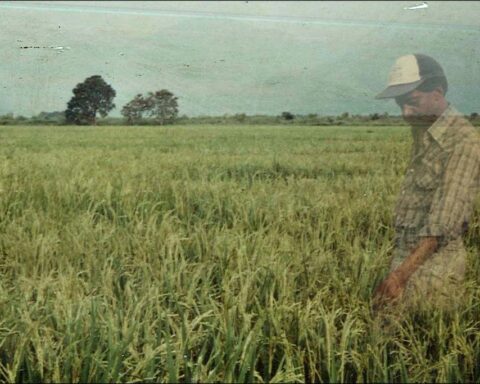Ping’an yueqing
(China, 103 min.)
Written and directed by Ai Weiwei
Art and activism rarely go hand in hand as perfectly as they do in the work of Ai Weiwei. The Chinese artist and filmmaker offers a boldly confrontational oeuvre. His work, which the feature documentary Ai Weiwei: Never Sorry chronicled especially well (the film opened the 2012 Hot Docs Film Festival), provocatively interrogates the state of his native China. His film Ping’an yueqing might be his most engaged work of activism as a filmmaker, for the documentary sees Ai lead a quest for truth following a brutal incident in which Chinese authorities allegedly conspired to assassinate the leader of a small town. The film is a chilling exposé: a portrait of a nation under surveillance.
Ping’an yueqing investigates the 2010 death of Qian Yunhui, a village leader from Yueqing in the eastern province of Zhejiang, who died under suspicious circumstances that authorities deemed a road accident. The film recounts Qian’s death in which he was crushed by the wheels of a truck. It offers the brutal, shocking, and gut-wrenching images of the man sprawled under the tires with his severed head protruding from underneath the automobile. The gruesome images are shocking sights that made international headlines and immediately aroused suspicion, yet Ai’s documentary shows that specialists in the Chinese police and government were among the few parties who initially thought the fatal incident was foul play.
Ping’an yueqing assumes the inquiry that the authorities fail to pursue as ordinary people mount a “citizens investigation” in the hunt for truth and justice. Ai’s camera assumes the role of lead detective as the filmmaker and his crew become unofficial leaders in the search. The case reveals that Qian fought the government when the villagers’ land was confiscated and likely paid the price for speaking out against an oppressive regime.
The images and scenes sometimes border upon exploitative, as Ai continually documents subjects and potential witness even when they expressly ask him not to film them. The villagers believe that the film puts their lives at risk and one must watch Ping’an yueqing and consider how much that wish is to be respected when one man is already dead. Alternatively, the opening image of Qian’s father as he weeps with grief offers an extremely difficult entry point to the story, but it also frames Ai’s quest within the gravity of the loss at hand. One life is already gone.
The most chilling evidence, however, comes from Qian himself. Ping’an yueqing offers point of view data taken from the victim’s wristwatch as he records images of his final walk through the village. Rough and tumble footage, like grainy, shaky GoPro or iPhone footage, documents the man’s last steps through Yueqing as he strolls down the street before the truck overtakes him. It’s the walk of a dead man. The images are unsettling, for although they show little within the frame, they capture the journey from life to death in a swift blow. The images afford the viewer two-minutes of firsthand experience that show a day in the life of the impoverished village as Qian walks at a decent pace and the camera hops with every step he takes until it jars quickly and tumbles as the wheels of the truck crush him. The camera then rests as Qian lies dead. The film doesn’t even need to cut back to the horrific image of Qian’s mangled body to suggest that he died a horrible death.
The evidence in the film features eyewitness testimony as well as some accounts that are highly speculative and circumstantial but the film finds especially damning proof in the reprisals that occur against villagers who, like Qian, stand up for what is right. But Ai also captures several villagers who revert from being open participants to closed turtles after they presumably received governmental threats. Several witnesses recant or alter their stories after the authorities intervene and detain them. The horror, paranoia, and genuine fear of death and violence that Ai’s camera finds frozen on the faces of the villagers says more than any of their words could express. The case against the government is elusive and ineffable, yet palpable.
While Ping’an yueqing builds a strong circumstantial case that holds the Chinese government accountable for Qian’s murder, the film is more successful as a bone-chilling portrait of a nation that lives in fear. People don’t carry such paranoia without reason, especially in such large numbers, and the about-faces that Ai encounters from witnesses offer convincing evidence of foul play. More significant is the genuine fear and discomfort the director captures whenever his camera reveals itself to the villagers. An overwhelming number of them escape the camera’s gaze or hide themselves from view. Many flat-out refuse to speak but insinuate that something afoul has gone on in the area. They fear that lending their voices to Ai’s call for justice could make them the next target. As Ping’an yueqing tours the village, it shows a population paralysed by fear. It’s an unnerving and eye-opening account of contemporary China.
The film challenges the heavily censored images of China that frequently make their way to Western screens and TV sets and is therefore an essential text for doc fans to explore. The film shows the democratic power of the camera as it empowers an artist and brave everyday citizens to create their own public record when a government would rather erase its citizens from the streets. It’s strong work even if it doesn’t ultimately solve the specific case at hand, for it boldly presents a crime that implicates innumerable victims—-and a troubled nation.
Ping’an yueqing screens at TIFF Lightbox on Thursday, November 10 as part of the Crisis of the Real: New Chinese Independent Documentaries series. Programmer Shelly Kraicer will introduce the screening.
For more coverage of the programme, please visit the POV feature on Cut Out the Eyes, The Last Moose of Aoluguya, and The Satiated Village. (Check back for more coverage!)
POV readers may also watch the film in its entirely below, courtesy of Ai Weiwei’s YouTube channel:











